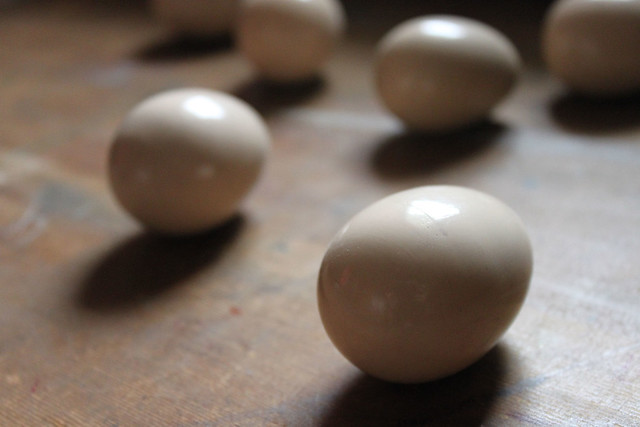Painted wooden eggs from various handicraft exhibitions and a pinecone souvenir from a trip to Kodaikanal.
>O<
"Pick up a pinecone and count the spiral rows of scales. You may find eight spirals winding up to the left and 13 spirals winding up to the right, or 13 left and 21 right spirals, or other pairs of numbers. The striking fact is that these pairs of numbers are adjacent numbers in the famous Fibonacci series: 1, 1, 2, 3, 5, 8, 13, 21... Here, each term is the sum of the previous two terms. The phenomenon is well known and called phyllotaxis. Many are the efforts of biologists to understand why pinecones, sunflowers, and many other plants exhibit this remarkable pattern. Organisms do the strangest things, but all these odd things need not reflect selection or historical accident. Some of the best efforts to understand phyllotaxis appeal to a form of self-organization. Paul Green, at Stanford, has argued persuasively that the Fibonacci series is just what one would expects as the simplest self-repeating pattern that can be generated by the particular growth processes in the growing tips of the tissues that form sunflowers, pinecones, and so forth. Like a snowflake and its sixfold symmetry, the pinecone and its phyllotaxis may be part of order for free"
~ Stuart Kauffman (At Home in the Universe: The Search for the Laws of Self-Organization and Complexity)
>O<
"Pick up a pinecone and count the spiral rows of scales. You may find eight spirals winding up to the left and 13 spirals winding up to the right, or 13 left and 21 right spirals, or other pairs of numbers. The striking fact is that these pairs of numbers are adjacent numbers in the famous Fibonacci series: 1, 1, 2, 3, 5, 8, 13, 21... Here, each term is the sum of the previous two terms. The phenomenon is well known and called phyllotaxis. Many are the efforts of biologists to understand why pinecones, sunflowers, and many other plants exhibit this remarkable pattern. Organisms do the strangest things, but all these odd things need not reflect selection or historical accident. Some of the best efforts to understand phyllotaxis appeal to a form of self-organization. Paul Green, at Stanford, has argued persuasively that the Fibonacci series is just what one would expects as the simplest self-repeating pattern that can be generated by the particular growth processes in the growing tips of the tissues that form sunflowers, pinecones, and so forth. Like a snowflake and its sixfold symmetry, the pinecone and its phyllotaxis may be part of order for free"
~ Stuart Kauffman (At Home in the Universe: The Search for the Laws of Self-Organization and Complexity)





No comments:
Post a Comment